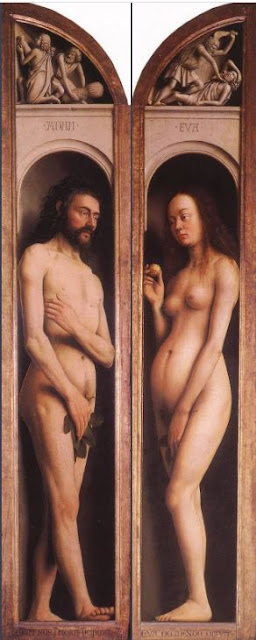Shared by Rebeca González:
The work of art I have chosen is is the polyptych of The Mystic Lamb by the Van Eyck brothers.There are many reasons, but it is mainly because it allows me to deepen in concepts such as the donor and also, transversally, in the events that this work suffered throughout history, especially in the theft of it by the Nazis during the Second World War and the recovery of it by the Monuments Men.
The work is located in the Cathedral of St. Bavo in Ghent, Belgium, and is one of the largest altarpieces in northern Europe and the most iconographically important in the 15th century.
It is considered to be the last work of the Middle Ages and the first painting of the Renaissance, as well as the first large oil painting in history, and it still holds one of the greatest mysteries in the history of art.
The theme of the work is complex: it is based on the Apocalypse of St. John.
The lamb is the symbol of Christ, but there are more elements related to salvation, such as Adam and Eve. On the Adam and Eve tablets, there are scenes of Cain and Abel. The anatomical representation of the figures of Adam and Eve is perfect.
As these pupils have already had history in the second year of ESO, they are familiar with this stage to which the Van Eyck work belongs. They can be asked who the naked figures (Adam and Eve) are and what they know about them. This would also refer to Cain and Abel.
On the central panel, one could ask who is the man dressed in red (God) and why is he dressed in red (the colour of passion). Why is he crowned and carrying the sceptre and blessing with his hand. Who are the figures to his right and left (the Virgin and John the Baptist). The colours of their clothes refer to their identity.
The angel musicians are an exercise in idealisation on the one hand and naturalism on the other, as they are depicted singing as a common choir.
The lower part of the panels on the left-hand side depict judges and knights such as Saint George and the French king Saint Louis as symbols of justice and fortitude.
On the right-hand panels Hermits and pilgrims, who were highly esteemed in the Middle Ages. The first one shows hermits such as St. Anthony Abbot and in the background Mary Magdalene with her jar of ointment, and the second one shows pilgrims such as the enormous St. Christopher and St. James, symbols of temperance and prudence.
The central table shows the worship of the mystical lamb.
Here we could ask what the well symbolises (the source of life), what characters appear that you can identify (the patriarchs Noah or Moses, the apostles...), what meaning does the water have (baptism) What the lamb symbolises (Christ according to the Apocalypse) and why it bleeds (represents the Eucharist). What the angels carry (instruments of the passion). What can we see in the background (the city of Ghent) and what does it symbolise (the heavenly Jerusalem).
With the polyptych closed, many more iconographic motifs could be explored, such as the Annunciation, prophets and sibyls, St John the Baptist and St John the Evangelist.
However, what is most interesting is the emphasis on the donors, whose portraits are depicted without idealisation, with all their imperfections.
What is the reason?
Apart from the fact that human and not divine persons are represented, the fact of representing them with all their ugliness and imperfections is due to the fact that they could be easily identified.
In short, this work allows us to carry out an interesting exercise in observation and learning, both in history and in art, and to explore iconography in depth.








No hay comentarios:
Publicar un comentario